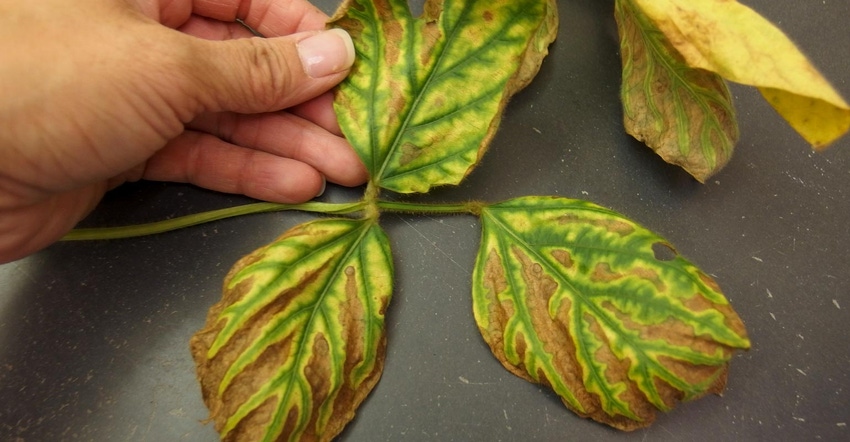September 9, 2020

Sudden death syndrome is showing up in soybean fields across the state.
University of Missouri Extension plant pathologist Kaitlyn Bissonnette says she is not surprised that the yield-robbing disease has reared its ugly head.
Fields showing symptoms now have had root infection for months, she says. SDS begins in wet springs such as this year’s, when the soilborne pathogen Fusarium virguliforme infects soybean roots. Rain during the reproductive growth stages allows the pathogen’s toxins to move from the roots to the leaves. SDS appears in both upland and river bottom fields.
Because SDS is soilborne, it is important to monitor fields with a history of the disease.
Identifying SDS
Foliar symptoms include yellow blotches between leaf veins that turn brown in the center. As the disease progresses, the leaves curl upward and may fall from the plant.
Stem canker and brown stem rot cause similar foliar symptoms, so it is important to scout and properly diagnose disease to form effective management strategies.
Damage ranges from trace losses up to 80%, depending on variety and when symptoms first appear. Yield losses of 5% to 15% are most common.
While there is no rescue treatment once SDS appears, producers can take preventive measures.
Keep a record of fields where SDS occurs. Consider planting resistant varieties and using seed treatments during the next season, Bissonnette says.
Foliar symptoms of SDS are sometimes worsened in fields infested with soybean cyst nematode. If you have never tested a field for SCN or it has been several years since your last SCN test, consider soil sampling this fall after harvest, Bissonnette says.
Management options include variety selection, improving drainage, avoiding continuous soybeans and managing SCN. Seed treatments labeled for SDS may provide additional early-season protection.
Potential treatment on horizon
Mirian Pimentel, a Ph.D. student, and a group of plant pathologists at Southern Illinois University recently discovered a promising new tool to fight SDS. Her research was published in Plant Disease.
They observed that several biological control agents, or beneficial fungi, were able to substantially reduce the growth of the underlying pathogen agent of SDS.
They found that isolates from the genera Trichoderma showed the highest inhibition of SDS pathogen growth and even reduced root rot. Additionally, these agents interacted with soybean plants to colonize their roots and activate plant defense-related genes, which help the soybeans fend off attacks from pathogens.
This research highlights the possibility for future use of biological control in soybean production to manage SDS.
Source: University of Missouri Extension and the American Phytopathological Society, which is solely responsible for the information provided and is wholly owned by the source. Informa Business Media and all its subsidiaries are not responsible for any of the content contained in this information asset.
You May Also Like




